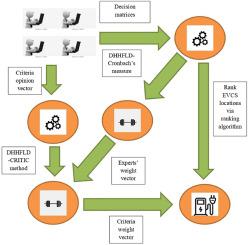当前位置:
X-MOL 学术
›
Eng. Appl. Artif. Intell.
›
论文详情
Our official English website, www.x-mol.net, welcomes your feedback! (Note: you will need to create a separate account there.)
A multi-criteria framework for electric vehicle charging location selection using double hierarchy preferences and unknown weights
Engineering Applications of Artificial Intelligence ( IF 8 ) Pub Date : 2024-04-01 , DOI: 10.1016/j.engappai.2024.108251 Raghunathan Krishankumar , Fatih Ecer
Engineering Applications of Artificial Intelligence ( IF 8 ) Pub Date : 2024-04-01 , DOI: 10.1016/j.engappai.2024.108251 Raghunathan Krishankumar , Fatih Ecer

|
The adverse effects of traditional vehicles on the environment increase the demand for clean vehicles, such as electric vehicles (EVs). The correct positioning of the charging points for such vehicles certainly promotes the acceptance and spread of EVs. Indeed, selecting optimal locations for electric vehicle charging stations (EVCS) is crucial for shaping a sustainable future. This study introduces an integrated methodology under a double hierarchy linguistic context with a criteria importance through an inter-criteria correlation (CRITIC) technique for experts' reliability determination, an attitudinal Cronbach's method for criteria weight estimation, and a novel multi-criteria technique considering the compromise ranking of alternatives from distance to ideal solution (CRADIS) formulation for optimal EVCS location selection. Based on the results, criteria such as are the most crucial, with Manapparai, India, as the optimal location for a new EVCS construction. Further, a crucial finding is that the social dimension is substantial compared to the economy and environment dimensions for EVCS location selection. The novelty of the paper is that (i) uncertainty and expression of choices in natural language form for locations for EVCS are modeled effectively using a double hierarchy structure, (ii) experts' weights are obtained methodically by considering hesitation and interactions among experts, (iii) interdependencies among criteria and importance of experts are considered during criteria weight determination, and (iv) locations are ranked by not only considering criteria type but also resembles closely to the human-centric decision process. A detailed sensitivity analysis is further conducted to prove the proposed approach's effectiveness and stability. In the context of sustainable transportation, the work could contribute to the relevant literature through a powerful decision-making tool.
中文翻译:

使用双重层次偏好和未知权重的电动汽车充电位置选择的多标准框架
传统汽车对环境的不利影响增加了对电动汽车(EV)等清洁汽车的需求。此类车辆充电站的正确定位无疑会促进电动汽车的接受和普及。事实上,选择电动汽车充电站 (EVCS) 的最佳位置对于塑造可持续的未来至关重要。本研究介绍了一种双层次语言环境下的综合方法,通过用于专家可靠性确定的标准间相关性(CRITIC)技术、用于标准权重估计的态度克朗巴赫方法以及考虑到标准重要性的新型多标准技术折中从距离到理想解决方案 (CRADIS) 公式的替代方案排序,以实现最佳 EVCS 位置选择。根据结果,最重要的标准是印度马纳帕莱 (Manapparai),它是新 EVCS 建设的最佳地点。此外,一个重要的发现是,与经济和环境维度相比,EVCS 位置选择的社会维度更为重要。该论文的新颖之处在于(i)使用双层次结构有效地对 EVCS 位置的自然语言形式选择的不确定性和表达进行建模,(ii)通过考虑专家之间的犹豫和交互来系统地获得专家的权重,( iii) 在标准权重确定过程中考虑了标准之间的相互依赖性和专家的重要性,以及 (iv) 位置的排名不仅考虑了标准类型,而且与以人为中心的决策过程非常相似。进一步进行了详细的敏感性分析,以证明所提出方法的有效性和稳定性。在可持续交通的背景下,这项工作可以通过强大的决策工具为相关文献做出贡献。
更新日期:2024-04-01
中文翻译:

使用双重层次偏好和未知权重的电动汽车充电位置选择的多标准框架
传统汽车对环境的不利影响增加了对电动汽车(EV)等清洁汽车的需求。此类车辆充电站的正确定位无疑会促进电动汽车的接受和普及。事实上,选择电动汽车充电站 (EVCS) 的最佳位置对于塑造可持续的未来至关重要。本研究介绍了一种双层次语言环境下的综合方法,通过用于专家可靠性确定的标准间相关性(CRITIC)技术、用于标准权重估计的态度克朗巴赫方法以及考虑到标准重要性的新型多标准技术折中从距离到理想解决方案 (CRADIS) 公式的替代方案排序,以实现最佳 EVCS 位置选择。根据结果,最重要的标准是印度马纳帕莱 (Manapparai),它是新 EVCS 建设的最佳地点。此外,一个重要的发现是,与经济和环境维度相比,EVCS 位置选择的社会维度更为重要。该论文的新颖之处在于(i)使用双层次结构有效地对 EVCS 位置的自然语言形式选择的不确定性和表达进行建模,(ii)通过考虑专家之间的犹豫和交互来系统地获得专家的权重,( iii) 在标准权重确定过程中考虑了标准之间的相互依赖性和专家的重要性,以及 (iv) 位置的排名不仅考虑了标准类型,而且与以人为中心的决策过程非常相似。进一步进行了详细的敏感性分析,以证明所提出方法的有效性和稳定性。在可持续交通的背景下,这项工作可以通过强大的决策工具为相关文献做出贡献。



























 京公网安备 11010802027423号
京公网安备 11010802027423号